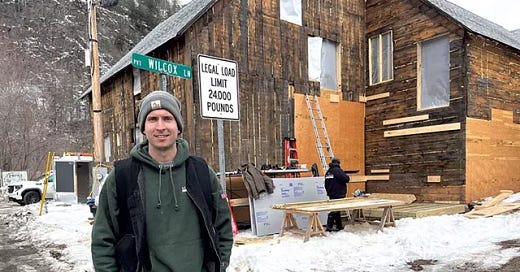Let's Actually Build Homes
How a proposed mini-TIF program could help developers meet the state's housing goals.
Hey — Jonah here.
Welcome back to Brick + Mortar, where I share stories on developing real estate at Village Ventures.
I joined the board of Let’s Build Homes last month, a group led by the former mayor of Burlington focused on policy to support, well… building more homes in Vermont.
And we need homes like Vermont needs a mild mud season—desperately and without delay.
24,000 to 36,000 homes in the next five years, to be (somewhat) exact.
Put another way—we need to be building 1,200 to 3,400 more homes per year than we already are.
Or, even better—we need to increase housing production by a factor of 30% to 100%.
All while addressing affordability. Else, we’ll continue to face issues with net migration and hit pieces from the likes of the WSJ (if I had $1 for every time someone sent me that article, I’d have paid off my IRS tax bill by now).
Either way, that’s a crazy target.
How do you spur such a dramatic increase in production?
Developers are simple humans. There are really only two things that determine whether we develop a site or not:
Entitlement: Will the municipality/state allow our project to be built?
Cost: Will the project make or lose money?
If development in Vermont was wildly profitable and easy, we wouldn’t be lagging demand by 30%+. Instead, most developers in our state are building as a labor of love and commitment to community—not because it’s a get-rich-quick scheme.
That said, projects still need to make sense financially or else they don’t get funded.
Let’s Build Homes is working on policy and programming to address obstacles affecting both entitlement and cost. You can find out more about those initiatives here.
For now, let’s talk about the Housing Infrastructure iniTiative (HIT) currently being proposed at the statehouse.
Housing Infrastructure iniTiative (HIT)
If you’re familiar with real estate, you probably know about Tax Increment Financing (TIF).
And if not—it’s a mechanism for municipalities to use the future increased property tax revenue from new development to pay for public infrastructure improvements that support that development.
In other words, it reduces the cost of a project for the developer and, in theory, allows the project to become financially viable.
Vermont has a whopping total of… nine TIF districts statewide.
And these districts encompass less than 15% of the state’s population.
The approval process to create a TIF district is complex, the financial risk is high, and state-imposed caps limit expansion—all of which make it difficult for many towns to justify or implement.
HIT aims to change that.
Instead of requiring towns to designate a special TIF district, HIT would allow individual projects to access the same benefits—making it far more accessible, especially for small-scale development.
If HIT is adopted, 80% of the incremental education tax generated from a new housing project in target growth areas could be used to finance infrastructure.
Take one of our projects as an example.
The Mill Street Cottages is a 15-home for-sale pocket neighborhood geared towards our workforce currently in pre-development:
Target sale price: $250-$300,000 for one and two bedroom starter homes
Total development cost: $3,900,000
Tax increment: $60,000 per year
Costs that could be supported by tax increment: $550,000
$550,000 is no joke.
That could easily mean the difference between a project pencilling out or not.
Now, TIF districts in Vermont have historically restricted use of tax increment proceeds to pay for public infrastructure. And that works just fine for larger, greenfield projects where city roads and water/sewer infrastructure need to be extended to accommodate new housing.
But what about smaller towns where we rely on private septic systems and parking?
Under current TIF legislation, these infrastructure costs aren’t eligible. I think they should be.
I’m not a TIF expert, but there are examples of other states/municipalities that provide much more flexibility in how TIF proceeds are put to work.
Kansas’ Reinvestment Housing Incentive District that was originally started to incentivize rural housing development is a good example. They even allow non-infrastructure capital improvements on residential construction to qualify.
I think the important guiding principle should be—define the type of development the state wants to see and incentivize around that.
In Vermont right now, that priority seems to be housing in target growth areas (e.g. village centers and downtowns) across the state. Not just a select few cities that already get the lion’s share of housing funds.
This is exactly what HIT has the power to do. That is, assuming it’s structured in a way that doesn’t box out smaller developers like us.
“But this sounds like just another handout to developers.”
No. No, it’s not.
Handouts are financial aid with no expectation of return. Think SNAP, unemployment benefits, and housing assistance programs. They’re given out to people in real need without any strings attached.
In contrast, subsidies are financial aid to support a specific economic activity or outcome. There’s got to be some sort of public benefit generated as a result of awarding a subsidy.
A subsidy isn’t a handout—it’s an incentive to make projects viable. And in Vermont, without subsidies, most projects in rural areas don’t get built at all.
We need programs like HIT to help us continue building the projects our communities need and deserve.
For another perspective, here’s a Seven Days article that was just published. Yours truly is featured!

Until next time.
— Jonah 🧱
P.S. Want to connect? Find me on LinkedIn.






Living in a cottage-type home in a pocket neighborhood has been a dream for a long time! Appreciate all of the good info and I hope we'll see more workforce housing throughout Vermont.
There is no doubt that VT needs more and more affordable housing. But the property tax system is too badly broken to further complicate with more use of TIF, which is a tool VT has been wise to limit given its use in other places, which is great at times, but subsidizes lots of projects with dubious public benefit. A more comprehensive vision and reform is needed.